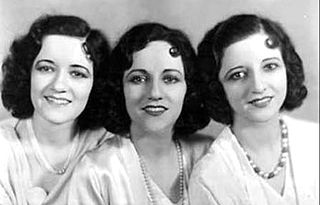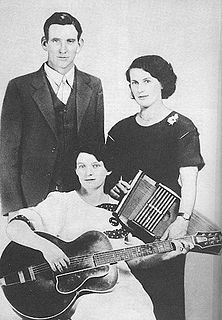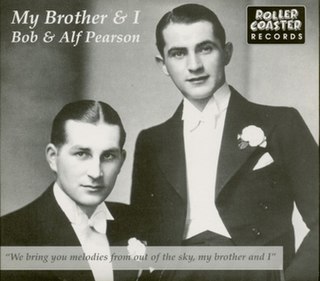Related Research Articles

The Boswell Sisters were an American close harmony singing trio of the jazz and swing eras, consisting of three sisters: Martha Boswell, Connee Boswell, and Helvetia "Vet" Boswell. Hailing from uptown New Orleans, the group blended intricate harmonies and song arrangements featuring effects such as scat, instrumental imitation, ‘Boswellese’ gibberish, tempo and meter changes, major/minor juxtaposition, key changes, and incorporation of sections from other songs. They attained national prominence in the United States in the 1930s during the twilight of the Jazz Age and the onset of the Great Depression.

The Carter Family was a traditional American folk music group that recorded between 1927 and 1956. Their music had a profound impact on bluegrass, country, Southern Gospel, pop and rock musicians as well as on the U.S. folk revival of the 1960s.

Kate Elizabeth Robbins is an English actress, singer and songwriter. She came to prominence in the early 1980s when she scored a top ten single on the UK Official Charts with 'More Than in Love', while she was appearing in the television soap opera Crossroads. She went on to become a prolific voice actress, most notably for nine years with the satirical show Spitting Image.

Harry Carroll was an American songwriter, pianist, and composer.

The Three X Sisters were an American all-girl harmony singing trio, initially known as The Hamilton Sisters and Fordyce. They were on stage singing together as early as 1922, and formed their trio in 1924, which was composed of Pearl Santos and Violet Hamilton from Cumberland, Maryland and Jessie Fordyce from Brooklyn, New York. They were known on NBC radio as "radio's foremost harmony trio."

Carroll Richard Gibbons was an American-born pianist, bandleader and popular composer who made his career primarily in England during the British dance band era.

Constance Foore "Connee" Boswell was an American female vocalist born in Kansas City but raised in New Orleans, Louisiana. With sisters Martha and Helvetia "Vet", she performed in the 1920s and 1930s as the trio The Boswell Sisters. They started as instrumentalists but became a highly influential singing group via their recordings and film and television appearances
"Don't Blame Me" is a popular song with music by Jimmy McHugh and lyrics by Dorothy Fields. The song was part of the 1932 show Clowns in Clover and was published in 1933. Popular versions that year were recorded by: Ethel Waters, Guy Lombardo, and Charles Agnew.
The Carter Sisters, were an American singing quartet consisting of Maybelle Carter and her daughters June Carter Cash, Helen Carter, and Anita Carter. Formed during World War II, the group recorded and performed into the 1990s.

The Brox Sisters were an American trio of singing sisters, enjoying their greatest popularity in the 1920s and early 1930s.
Anne Lenner (1912–1997) was a popular English female vocalist, singing with the dance bands of the 1930s and 1940s. She is most closely associated with Carroll Gibbons and the Savoy Orpheans, a band who regularly played at the Savoy Hotel in London; she made many studio recordings with this band. The British bands played a softer version of the swing jazz popular in the USA during the 1930s and 1940s.
Joseph Allan McIver was a Canadian composer, arranger, pianist, and conductor. As a pianist he performed with orchestras in the Quebec region in his early career and was the longtime accompanist and arranger for Trio lyrique. He had a long and fruitful relationship with the Canadian Broadcasting Corporation, serving as a music director, composer, arranger, conductor, and pianist for nearly four decades.

The Viennese Singing Sisters was a close harmony female singing group which originated in Austria in the late 1920s or in 1930, and which was active there, elsewhere in Europe, and in the Americas until the late 1930s. It made recordings, and appeared on radio and television and in film. It consisted of singers with vocal ranges from high soprano to contralto, one of whom would also play piano accompaniment. At various times, it had six or seven members. Despite the name, it seems never to have included any sisters.

The Landt Trio was one of the busiest singing groups in early radio. In 1928, the three brothers, Karl (1908–1997), Jack (1911–1959), and Dan (1896–1961) Landt, with their accompanist Howard White, were signed onto the NBC Blue Network as sustaining artists and began a career of more than 20 years. They performed primarily on radio but also performed in vaudeville, including some headline runs at the Palace and Carnegie Hall, and made many personal appearances. They were unusual in the music world in that they did not read music, so they sang and played by ear. They continued to perform on radio and in advertising until the early 1950s, when the rising popularity of television ended their performance career.
Theodore Samuel Holland, OBE, was a British composer and academic.
Eva Alaine Overstake, professionally known as Judy Martin, was an American country music singer, performing from the early 1930s to the late 40s on the WLS-AM's National Barn Dance in Chicago. She was the second wife of Country Music Hall of Fame member Red Foley and is the grandmother of Christian country music singer Debby Boone.
The DeMarco Sisters were an American close harmony singing group of the big-band era who recorded popular music and performed in concerts and on the radio, television, and on film from the 1930s through the 1960s. They first achieved fame as weekly performers on The Fred Allen Show from 1946 to 1949, and were featured singers in the 1952 film Skirts Ahoy! with actress Esther Williams. The group was initially composed of five biological sisters. Music critics have compared their sound and style to that of The King Sisters. They made recordings for Majestic Records and Mercury Records among other labels.
Felix Mendelssohn's Hawaiian Serenaders was a popular Hawaiian music band started by British frontman Bartholdy Felix Mendelssohn. They are best known for making Hawaiian music popular in England and throughout Europe during the late 1930s and throughout the 1940s. The group were based in London.

Bob and Alf Pearson were an English musical variety double act, consisting of brothers Robert Alexander 'Bob' Pearson and Alfred Vernon 'Alf' Pearson, who were mainly known for singing songs in close-harmony as a duo. Their career together lasted over 50 years, spanning stage, radio, television and gramophone records.

Norman MacPhail Blair, who most often used the pseudonym Maurice Elwin in his professional work, was a British dance band singer and songwriter who was popular between the First and Second World Wars. He used over 60 different pseudonyms, both as a singer and composer, including John Curtis, Maurice Kelvin, Donald O'Keefe, Guy Victor, and Max Wynn, as well as sometimes using the name Norman Blair.
References
- ↑ John Wright, British Music Yearbook, 2001
- ↑ John Scott-Taggart, "How They Began", Wireless and Television Review, 1935, p.124
- 1 2 Denis Gifford, The Golden Age of Radio, B.T. Batsford Ltd, London, 1985, ISBN 0-7134-4235-2, p.45
- ↑ Peter Cliffe, Fascinating Rhythm, 1990, p.165
- 1 2 Search, Carlyle Cousins, Radio Times, BBC Genome. Retrieved 15 March 2021
- ↑ Nathan Davis, "Carroll Gibbons & his Boyfriends – A Discography", 78rpm Community. Retrieved 15 March 2021